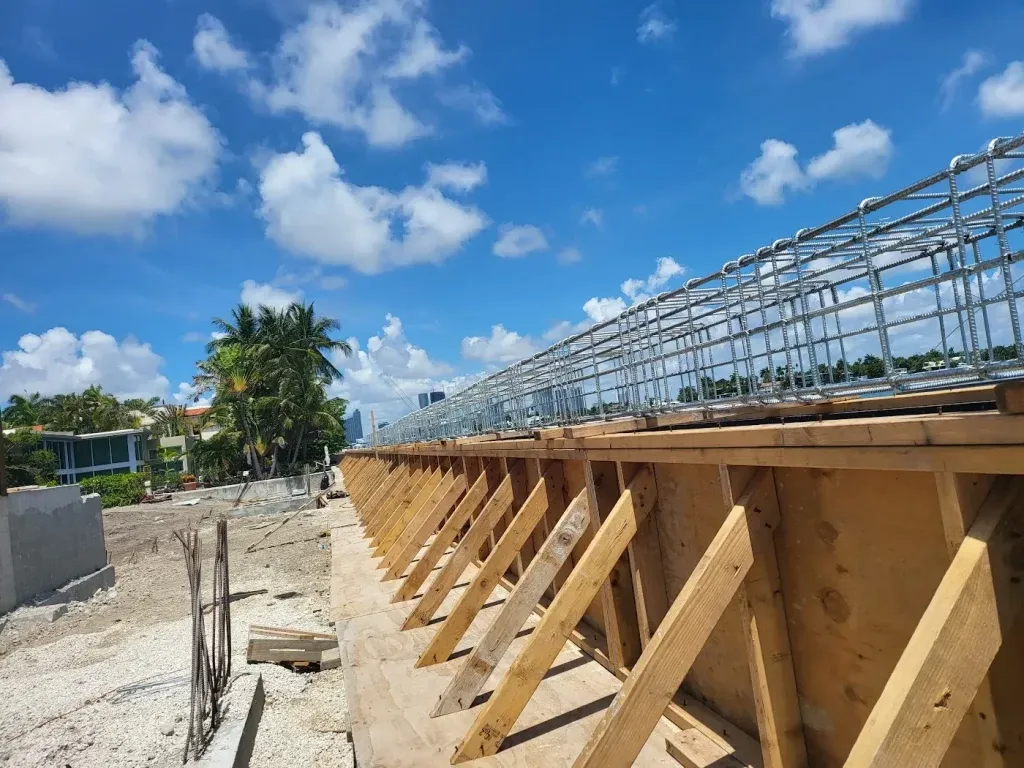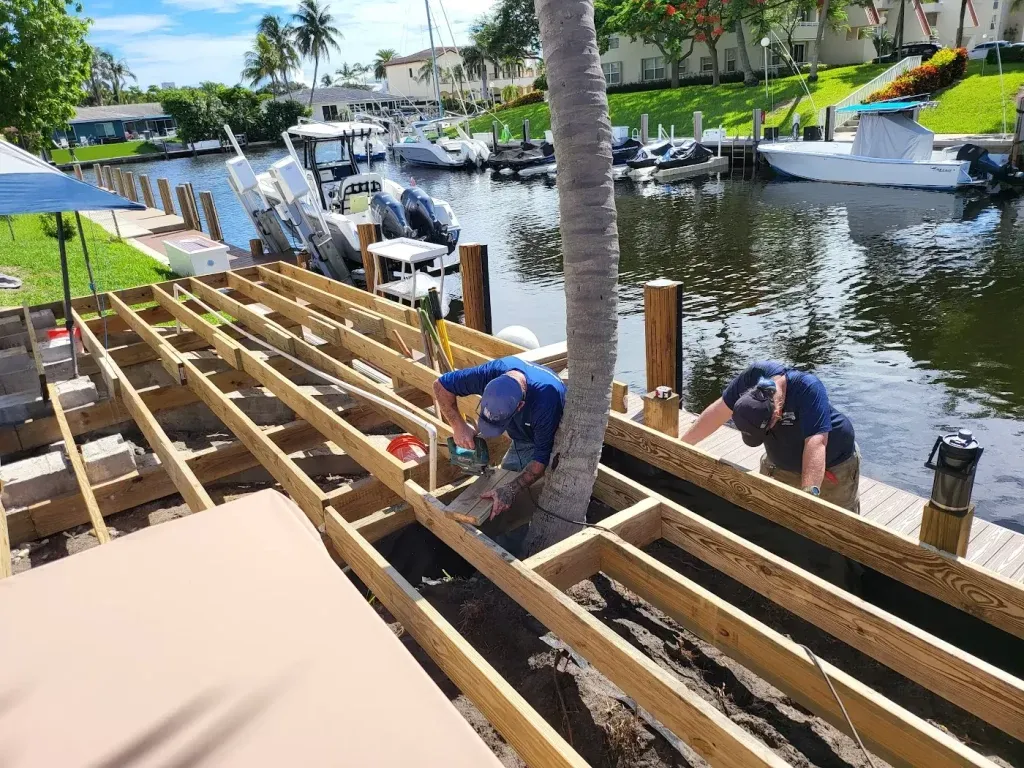Seawalls and bulkheads are essential coastal structures designed to protect shorelines from erosion and flooding. As these structures age and suffer damage, property owners face the decision, especially if signs your seawall needs repair are evident, of whether to repair or replace their existing seawall or bulkhead. Understanding when to replace a seawall is crucial in this decision-making process. This article highlights the differences between repairing and replacing these structures, discussing the advantages and disadvantages of each option, as well as variations in cost, environmental impact, and long-term maintenance. Furthermore, it outlines the key steps involved in the repair and replacement processes, including the necessary permits and alternatives to traditional methods. Whether your seawall or bulkhead is already deteriorating or you are planning for the future, understanding these options is crucial for ensuring the safety of your coastal property.
What Are Seawalls and Bulkheads?
Seawalls and bulkheads are types of marine structures designed to offer effective shoreline protection methods from erosion and other environmental forces. Seawalls are constructed from concrete or stone and serve as barriers against wave action and other forces, functioning as a method of marine structure maintenance.
In contrast, bulkheads are retaining walls that help manage soil, providing essential retaining wall erosion solutions and water levels along the coast, providing essential shoreline protection.
Have Any Questions?
Repairing vs Replacing Seawalls and Bulkheads: What Are the Key Differences?
Repairing seawalls and bulkheads involves fixing damaged areas to extend the service life of the existing structures. In contrast, replacing seawalls and bulkheads entails completely removing the old wall and installing a new one. When comparing repairing vs replacing seawalls, both processes address localized sections, but they differ significantly in scope and implications.
Seawall repair can be categorized into structural and cosmetic types. Structural repairs focus on fixing damage to the seawall’s core, such as cracks or holes in the concrete. Cosmetic repairs, on the other hand, aim to enhance the wall’s appearance, often by applying a new coating. Seawall replacement is generally considered a last resort, undertaken only after all possible repairs have been exhausted, as it is typically much more expensive than repairs.
For bulkheads, repairs are often localized, such as restoring a specific section of rusted sheets. Due to the relatively shallow nature of most bulkhead applications, dredging is frequently necessary to access the bottom of the wall during repairs. In instances of damage, a bulkhead can sometimes be pushed back into place if the damage is not severe; however, there are cases where complete replacement with new materials is required.
When weighing the options of repairing versus replacing seawalls and bulkheads, several factors come into play. Repairing seawalls and bulkheads has its advantages: repairs are generally less expensive but may not be as durable in the long run compared to replacements. Replacing seawalls and bulkheads offers the benefit of increased durability, yet this option typically comes at a higher cost. Ultimately, the decision to repair or replace requires careful consideration of the pros and cons of seawall repair and bulkhead repair vs replacement, alongside other factors such as cost, expected lifespan, and environmental impact.
For a deeper understanding of seawall maintenance and the factors influencing repair decisions, consider exploring Seawall Repair: Identifying Damage and Planning Repairs.
What Are the Pros of Repairing Seawalls and Bulkheads?

Seawall repair and bulkhead repair offer numerous advantages and is often an effective way to maintain these structures without the need for complete replacement. One of the most significant benefits of repairing seawalls and bulkheads is that it is typically much less expensive than a total replacement. This approach allows property owners to protect their investments while addressing issues such as cracks or erosion. Timely repairs can also help extend the useful life of a seawall or bulkhead.
It is essential for homeowners to recognize the signs that indicate their seawall needs repair in order to maintain the integrity of these marine structures. Furthermore, choosing to repair rather than replace has the added benefit of preserving existing local ecosystems.
Here are three key benefits of repairing seawalls and bulkheads instead of replacing them:
- Cost-Effectiveness: Repairing is generally less expensive than replacing, providing significant cost savings for property owners.
- Longevity: Regular maintenance and repairs can extend the useful life and effectiveness of these structures in minimizing erosion and storm damage.
- Environmental Benefits: Repairing existing structures minimizes disruption to the coastal habitat that often accompanies a complete rebuild, leading to a healthier marine ecosystem.
What Are the Cons of Repairing Seawalls and Bulkheads?
Repairing seawalls and bulkheads has several drawbacks, the most significant of which include the following.
- Frequent repairs can sometimes prove to be a false economy, as the cumulative costs may exceed those of replacing the structure in the long run.
- Moreover, repairs often serve as temporary solutions.
- If not executed properly, underlying issues—such as loss of structural integrity or extensive erosion—that necessitated the original repair may continue to deteriorate.
- It is essential to weigh the pros and cons of repairing versus replacing a seawall, especially if ongoing repairs fail to prevent structural failure.
- Continuous repairs may keep a structure in place, even as its condition declines, potentially delaying the need for a more sustainable long-term solution.
- Additionally, logistical challenges during the repair process can disrupt local ecosystems and lead to increased costs due to delays.
Other disadvantages of seawall and bulkhead repairs include the following:
- Frequent maintenance costs, as ongoing repairs can accumulate over time;
- Temporary solutions, since many repairs do not address the underlying causes of deterioration and will require further investment in the future;
- And, outdated materials and methods, which often provide limited value and do not meet modern standards.
For these reasons, decision-makers in environmental and maritime management must carefully consider whether continuing to repair these structures aligns with their long-term plans.
What Are the Pros of Replacing Seawalls and Bulkheads?

Seawall replacement and bulkhead replacement offer numerous benefits that are essential for effective marine structure maintenance and long-term shoreline protection. One of the main advantages of replacing these structures is the opportunity to utilize modern materials and technologies that provide enhanced durability and resilience against environmental forces. This ensures superior protection against erosion and reduces the frequency of future repairs, ultimately leading to lower long-term maintenance costs.
New designs often incorporate innovative features, such as improved drainage systems that help mitigate water buildup, eco-friendly materials that support local ecosystems, and adaptive structures that effectively respond to rising sea levels. By integrating these advancements, the replacement process not only protects property but also positively impacts the surrounding environment, creating a win-win scenario for both natural habitats and community assets.
What Are the Cons of Replacing Seawalls and Bulkheads?
Despite the significant advantages of replacing seawalls and bulkheads, there are numerous disadvantages that can impact property owners and the environment. Some of these disadvantages include the following:
- Firstly, the cost of replacing seawalls and bulkheads is often much higher than that of repairing them, requiring a substantial upfront financial investment. This can pose a challenge for many property owners who may lack the resources for such replacements.
- Additionally, the process of replacement can lead to environmental disruptions, harming local ecosystems and habitats during construction.
- Moreover, property owners must factor in the ongoing maintenance costs associated with new structures, which can accumulate over time. This scenario can result in a situation where the short-term benefits are overshadowed by long-term financial burdens.
Furthermore, the following negative outcomes can be anticipated:
- Property values may not increase as much as expected following replacement, and legal and insurance liabilities may rise, particularly if the new structures fail to perform as intended.
- Environmentally, the alteration of natural landscapes can lead to several risks, including habitat disruption—resulting in a loss of biodiversity and changes in animal migration patterns—and increased soil erosion, which heightens the vulnerability of inland areas to flooding.
In summary, even though the primary objective of replacing seawalls and bulkheads is often to enhance erosion protection, it is essential to carefully weigh these disadvantages against their purported benefits.
What Are the Factors to Consider When Deciding on Repairing vs Replacing Seawalls and Bulkheads?
When determining whether to repair or replace seawalls and bulkheads, several factors must be taken into account. These include the condition of the existing structures, cost estimates for repairs compared to replacement, long-term maintenance requirements, and environmental implications.
These factors are essential in making an informed decision on the best approach to protect coastal integrity.
Cost
Cost, including the cost of seawall repair, is one of the most significant factors to consider when deciding between repairing or replacing a seawall and a bulkhead, as it directly impacts the financial feasibility of each option. Generally, seawall repair involves lower initial costs, enabling homeowners to address immediate concerns without incurring substantial expenses. In contrast, seawall replacement may require a higher upfront investment, especially if the existing structure is severely compromised. Understanding the cost implications of each approach allows property owners to make informed decisions that align with their budget.
When evaluating these options, it is crucial not only to consider the initial financial outlay but also the long-term investment. While repairing a seawall may be more cost-effective in the short term, property owners must also take into account future maintenance costs and the potential for recurring issues.
Several factors to weigh include:
- Material Durability: Some repairs may only provide a temporary solution to underlying problems, leading to further expenses down the line.
- Labor Costs: The cost of skilled labor can vary significantly depending on the complexity of the repairs compared to the installation of new structures.
- Environmental Considerations: New regulations may affect the costs and options for replacements.
By thoroughly examining these financial aspects, homeowners can ensure they choose the most suitable solution, ultimately protecting their investments while navigating these critical decisions.
Age and Condition of the Structure
The age and condition of a seawall or bulkhead are critical factors in determining whether these coastal structures should be repaired or replaced. Older structures may have underlying issues that are not immediately visible; if their condition has deteriorated significantly, replacement may be necessary rather than just repairs. Conversely, if a newer structure is damaged by environmental factors, repair might be a more feasible solution.
Therefore, it is essential to carefully assess the age and condition of existing seawalls and bulkheads to evaluate their structural integrity and remaining lifespan, enabling informed maintenance decisions.
The importance of thorough evaluation is highlighted by examples demonstrating how poor maintenance choices can affect coastal protection and safety. For instance, older seawalls may exhibit visible shifting or erosion, compromising their structural integrity and effectiveness. Meanwhile, new bulkheads may require immediate repairs if they suffer damage from storms or marine growth, even if they remain structurally sound.
Routine inspections and evaluations not only facilitate timely repairs but also support long-term planning and investment decisions. Engaging marine engineers with expertise in these assessments allows property owners and municipalities to make informed decisions that protect their waterfront investments.
Environmental Impact
The environmental impact of repairing or replacing seawalls and bulkheads is a crucial consideration that can significantly influence decision-making. Repairing these structures can sometimes minimize disturbances to local marine ecosystems, thereby preserving wildlife and their habitats. In contrast, replacement may require larger-scale construction efforts, which can cause substantial disruptions to surrounding ecosystems. Therefore, evaluating the environmental impacts of each option is essential for effective shoreline protection methods and the preservation of local biodiversity.
When assessing this complex issue, several factors must be taken into account as part of the decision-making process. The impact on species migration is one such factor; repair options typically involve less work and are less likely to disrupt species that rely on these areas for migration or feeding. Additionally, sediment movement and erosion control are important considerations; the materials used in repairs should ideally mimic natural substrates to maintain the sediment dynamics essential for coastal health.
Understanding the long-term ecological consequences of repairs or replacements is also vital. An awareness of how these actions affect water quality and circulation patterns can lead to more informed decisions. An overall assessment of these factors contributes to the creation of effective defenses while emphasizing the importance of preserving coastal environments. Engaging marine biology and ecology experts in the discussion can help develop solutions that address human needs while allowing coastal ecosystems to thrive.
Long-Term Maintenance
When choosing between repairing or replacing a seawall and bulkhead, long-term maintenance considerations are crucial, as they influence the future upkeep and sustainability of these coastal structures. Structures that are repaired may require ongoing maintenance and frequent inspections, potentially leading to high costs over time. In contrast, replacing a seawall or bulkhead can result in a more durable, low-maintenance structure designed to withstand environmental forces for years to come. Understanding the long-term implications of each option is vital for effective marine structure maintenance.
The decision between repair and replacement involves evaluating several factors that can significantly impact maintenance efforts. For example, while repairing existing structures may initially appear cost-effective, it can lead to continuous investments in upkeep—especially if the material’s integrity is compromised. Conversely, a complete replacement often entails a higher upfront cost but can provide a structure engineered to resist erosion and adverse weather conditions, thereby minimizing future repair needs.
Ongoing maintenance programs for repaired structures may include various aspects:
| Aspect | Repair | Replacement |
| Cost | High over time | Lower in long term |
| Durability | Variable | High |
| Maintenance Frequency | High | Low |
Ultimately, a thorough evaluation of both repair and replacement options is essential for ensuring the longevity and performance of marine infrastructure.
What Are the Steps Involved in Repairing Seawalls and Bulkheads?
Repairing seawalls and bulkheads is a multi-step process that demands careful planning and execution to ensure effective maintenance and restoration of marine structures. The first step usually involves assessing the condition of the structure to identify specific areas that require repair.
After this assessment, a tailored repair plan is developed to address the identified issues. Once the plan is established, it is essential to select appropriate materials and methods to ensure durability and resilience against future environmental challenges.
The repair process itself may include tasks such as filling cracks, reinforcing structural elements, and applying protective coatings.
What Are the Steps Involved in Replacing Seawalls and Bulkheads?
The process of replacing seawalls and bulkheads is systematic and essential for the proper maintenance of marine structures and effective shoreline protection. It begins with an assessment of the current structure to evaluate its level of deterioration and determine whether replacement is necessary.
Next, plans must be developed to safely remove the existing structure while minimizing any impact on the surrounding environment. Once the old seawall or bulkhead has been removed, a new structure can be installed using modern materials and techniques that enhance durability and resistance to natural elements.
What Are the Permits and Regulations Involved in Repairing and Replacing Seawalls and Bulkheads?
Permits and regulations related to the repair and replacement of seawalls and bulkheads are crucial considerations that must be addressed to ensure compliance with local and federal laws. Typically, obtaining permits is necessary before initiating any project, and the requirements vary based on the project’s scope and location.
Laws and regulations governing marine structures often include stipulations regarding construction methods, materials used, and environmental protections designed to mitigate the project’s impact on local ecosystems. Failure to comply with these laws and regulations can lead to costly legal consequences and delays in the project timeline.
What Are the Potential Risks and Benefits of Repairing and Replacing Seawalls and Bulkheads?
Assessing the potential risks and benefits of repairing or replacing seawalls and bulkheads is essential for knowledge-based decision-making in the maintenance of marine structures, especially considering climate change impacts. Repairing these structures can provide immediate cost savings and extend their lifespan; however, it may also lead to increased long-term maintenance and the risk of structural failures if underlying issues are not addressed.
On the other hand, replacement offers the advantage of utilizing updated construction methods and materials that enhance durability and resilience, but it requires a significant upfront investment and may disrupt local ecosystems during construction. By evaluating these factors, property owners can carefully weigh their options and choose the best course of action.
What Are Some Alternatives to Repairing or Replacing Seawalls and Bulkheads?
Along with repairing or replacing seawalls and bulkheads, there are several effective alternatives for shoreline protection and erosion management. One such alternative involves natural solutions, such as planting vegetation, which can stabilize soil and trap sediment while enhancing the natural landscape and providing ecological benefits.
Furthermore, modern erosion control solutions, like geotextiles, green infrastructure, and flexible barriers, can effectively mitigate shoreline erosion without requiring heavy construction.For expert guidance on seawall alternatives and comprehensive marine construction solutions in South Florida, contact Sea Me Dive. Our experienced team has served the region for over 20 years, providing professional underwater maintenance and repair services. Reach us at 754-265-7115 to discuss the best shoreline protection options for your property.
